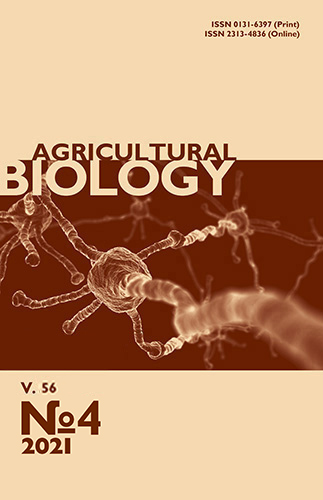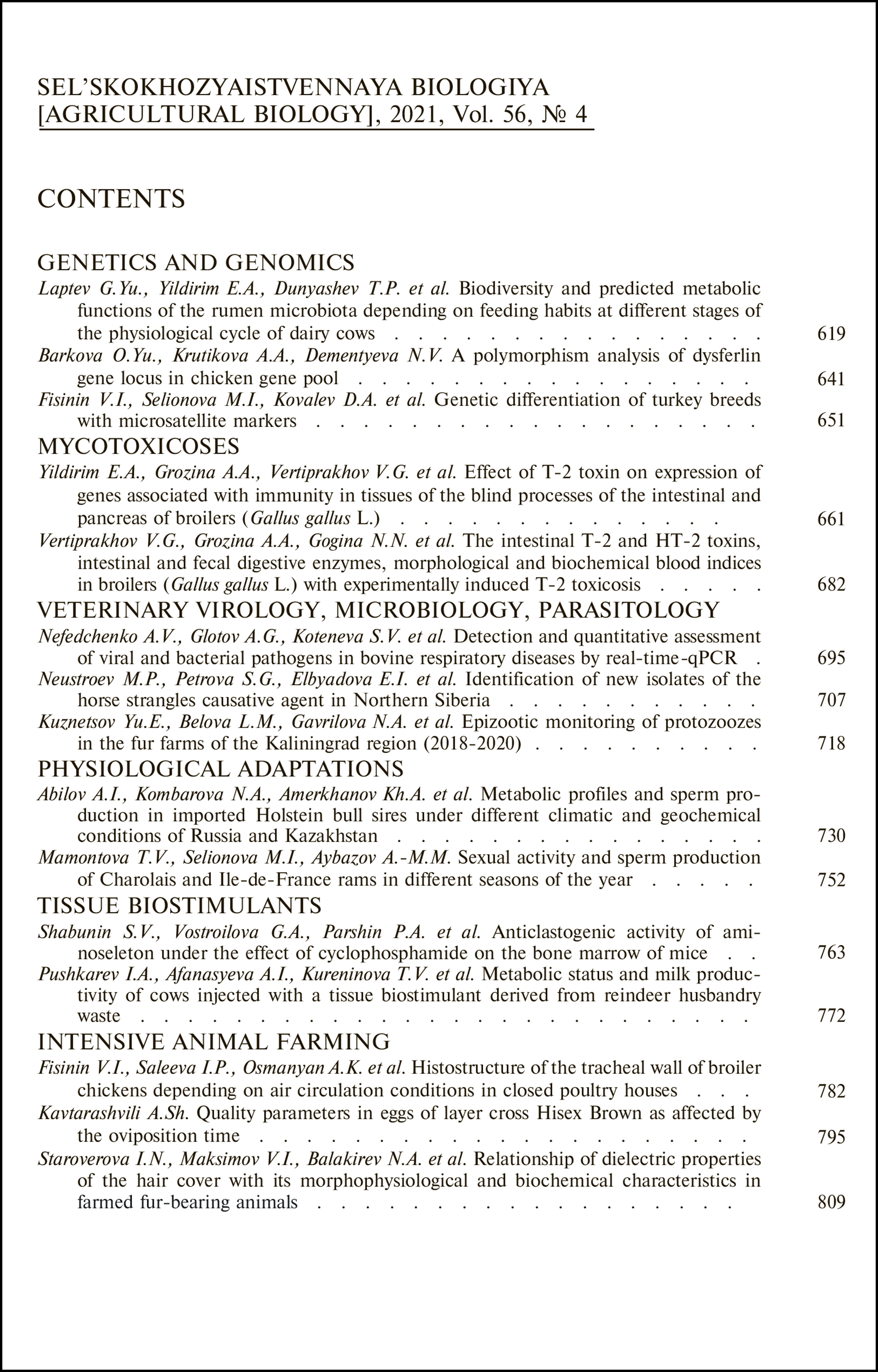doi: 10.15389/agrobiology.2021.4.809eng
UDC: 636.036.1:636.93:591.1:537.2
Acknowledgements:
Supported financially by the Russian Foundation for Basic Research within the frame of grant No. 20-016-00105/20 “Development of a pharmacologically active compound based on a polymer complex for the prevention and treatment of microelementosis in fur farming”
RELATIONSHIP OF DIELECTRIC PROPERTIES OF THE HAIR COVER WITH ITS MORPHOPHYSIOLOGICAL AND BIOCHEMICAL CHARACTERISTICS IN FARMED FUR-BEARING ANIMALS
I.N. Staroverova ✉, V.I. Maksimov, N.A. Balakirev, S.V. Pozyabin,
S.Yu. Zaitsev, A.A. Deltsov
Skryabin Moscow State Academy of Veterinary Medicine and Biotechnology, 23, ul. Akademika K.I. Skryabina, Moscow, 109472 Russia, e-mail irina_starovierova@mail.ru (✉ corresponding author), dr.maximov@gmail.com, Balakirev@mgavm, rector@mgavm, szaitsev@mail.ru, deltsov-81@mail.ru
ORCID:
Staroverova I.N. orcid.org/0000-0003-3762-9956
Pozyabin S.V. orcid.org/0000-0002-3825-6082
Maksimov V.I. orcid.org/0000-0002-5305-0218
Zaitsev S.Yu. orcid.org/0000-0003-1533-8680
Balakirev N.A. orcid.org/0000-0001-8980-263X
Deltsov A.A. orcid.org/000-002-0385-0321
Received April 12, 2021
The hair cover of furbearing animals is a dielectric material able to electrify with accumulation of static electricity charges. Electrically charged surface attracts dust particles causing loss of fur shine, accelerated aging, destruction and a decrease in strength characteristics and the quality of raw materials, as well as the transfer of static electricity charges when in contact, for example, with the human body. In this paper, for the first time, we proposean empirical equation describing the dielectric properties of natural fur and the interrelations between the composition and quality of the skin and hair covers with its electrophysical characteristics for different species of furbearing farm animals. The work aimed to study the influence of morphophysiological characteristics, biochemical composition (mineral and amino acid), and the state of the skin and hair on dielectric properties and to reveal relationships to more correctly assess the quality of fur raw materials. In the work, we used fur raw materials obtained from physiologically healthy silver-black foxes (Vulpes vulpes), silver foxes (Alopex lagopus), and standard minks (Mustela vison) (Zverosovkhoz Saltykovsky, Moscow Province). Hair density per 1 cm2 rump, the guard hair density per 1 cm2 rump, the linear dimensions of various types of hair, their thickness, the thickness of the rump skin, and the pelt area were measured and Na, Ni, B, V, Se, Al, Fe, K, I, Ca, Co, Mg, Mn, Cu, P, Cr, Zn, Si contents were determined. Amino acid analysis of biosubstrate hydrolysates was carried out for 17 amino acids. The pelts were tested for dielectric properties. The discharge kinetics equations were obtained at 20° C, 62 % relative humidity and voltage of 10.0, 18.5, and 28.5 kV (a HT-705 5kVA 50KV AC/DC high-voltage charge generator, Wuhan Huatian Electric Power Automation Co., Ltd., China). When assessing the quality of fur raw materials, a voltage of 9.5, 12.5, 15.5 and 18.5 kV was used. The charge leakage time constant and the change in the magnitude of the static electric field intensity at certain time intervals were determined. A comparison of the morphophysiological parameters of the skin and hair in different species of furbearing animals with the data on electrizability allowed us to derive an empirical equation reflecting the dielectric properties of the skin and hair — E = E0/е-t/τ, where E0 is the maximum value of the tension and τ is the charge leakage time constant. Correlation analysis showed close interrelations between the rate of charge runoff and the length and thickness of the guard hairs (r = 0.83-0.90 at p < 0.05), the density of the guard and down hair (r = 0.92-0.98 at p < 0.001), and the length of the down hairs (r = 0.94 at p < 0.001). The charge leakage closely correlated with the total mass of chemical elements in the hair and skin (r = 0.97; r = 0.97 at p < 0.05) and the total amino acid composition of the hair cover (r = 0.95 at p < 0.05). The E0 value closely correlated with the total mass of elements in the hair and skin, and with the amino acid composition of the hair cover (r = 0.90; r = 0.86; r = 0.99 at p < 0.05). Therefore, the dielectric properties of the skin and hair of furbearing animals depend on both the morphophysiological characteristics and biochemical composition. The skin and hair cover defects were established to affect the electrophysical parameters (τ and E0). Decreased fur density, haircut, broken awn, fur mattedness reduce the E0 index by 25-90 % and change the charge leakage time constant τ by 15-70 % compared to defect-free skins. The dielectric parameters E0 and τ provide more accurate fur quality estimates in silver-black fox, silver fox, and standard mink. The technology uses electrophysical measurements instead of not subjective organoleptic analysis.
Keywords: furbearing animals, Vulpes vulpes, silver fox, Alopex lagopus, Arctic fox, Mustela visonm, mink, skin cover, hair cover, dielectric properties, electrizability, mineral composition, amino acid composition, fur defects.
REFERENCES
- Golovteeva A.A., Kutsidi D.A., Sankin L.B. Laboratornyi praktikum po khimii i tekhnologii kozhi i mekha [Laboratory workshop on leather and fur chemistry and technology]. Moscow, 1987 (in Russ.).
- Staroverova I.N., Kuleshov I.V., Os'kina O.Yu., Zaitsev S.Yu., Maksimov V.I. Vozniknovenie staticheskogo elektrichestva na razlichnykh materialakh i metody ego otsenki [The emergence of static electricity on various materials and methods for its assessment]. Moscow, 2008 (in Russ.).
- Bychkova I.N. Razrabotka otdelochnykh kompozitsii na baze fibrillyarnykh belkov dlya ispol'zovaniya v proizvodstve mekha. Avtoreferat kandidatskoi dissertatsii[Development of finishing compositions based on fibrillar proteins for use in fur production. PhD Thesis]. Moscow, 2005 (in Russ.).
- Kislyakov A.G., Mordvinkin I.N. Biofizika, 2001, 46(1): 93-97 (in Russ.).
- Canids: foxes, wolves, jackals and dogs. Status survey and conservation action plan. C. Sillero-Zubiri, M. Hoffmann, D.W. Macdonald (eds.). IUCN/SSC Canid Specialist Group, Gland, Switzerland and Cambridge, UK, 2004.
- Balakirev N.A., Zaitsev S.Yu., Rizvanov A.A. Phenozan influence on the physiological-biochemical parameters of the young minks leading to their advanced properties. International Journal of Zoology, 2016, 2016: 2159509 CrossRef
- Damgaard B.M., Børsting C.F., Engberg R.M., Jensen S.K. Effects of high dietary levels of fresh or oxidised fish oil on performance and blood parameters in female mink (Mustela vison) during the winter, reproduction, lactation and early growth periods. Acta Agriculturae Scandinavica, Section A — Animal Science,2003, 53(3): 136-146 CrossRef
- Zhong W., Mu L.L., Han F.F., Luo G.L., Zhang X.Y., Liu K.Y., Guo X.L., Yang H.M., Li G.Y. Estimation of the net energy and protein requirements for maintenance of male Arctic foxes (Alopex lagopus) during the growth period1,2. J. Anim. Sci., 2019, 97(11): 4579-4587 CrossRef
- Cybulski W., Jarosz L., Chałabis-Mazurek A., Jakubczak A., Kostro K., Kursa K. Contents of zinc, copper, chromium and manganese in silver foxes according to their age and mineral supplementation. Pol. J. Vet. Sci., 2009, 12(3): 339-245.
- Zhong W., Liu H. Luo G., Chang Z. Liu F., Zhao J., Li D., Yue Z., Zhang H., Li G. Dietary copper supplementation improves pelt characteristics of female silver fox (Vulpes fulva) during the winter fur-growing season. Anim. Sci. J., 2014, 85(7): 757-762 CrossRef
- Fouda T.A., Youssef M.A., El-Deeb W.M. Correlation between zinc deficiency and immune status of sheep. Veterinary Research,2011, 4(2):50-55 CrossRef
- Staroverova I.N., Maksimov V.I., Zaitsev S.Yu. Doklady Rossiiskoi akademii sel'skokhozyaistvennykh nauk,2010, 5: 42-44 (in Russ.).
- Dayyani N., Beyki Bandar Abadi M., Amir Abadi Farhani A. Chelated minerals in animal nutrition. International Journal of Advanced Biological and Biomedical Research, 2013, 1(11): 1387-1391.
- Balakirev N.A., Kladovshchikov V.F. Normy zatrat kormov dlya pushnykh zverei i krolikov: Spravochnoe posobie [Feed cost rates for fur animals and rabbits: A reference guide]. Moscow, 2007 (in Russ.).
- Balakirev N.A., Maksimov V.I., Staroverova I.N., Zaitsev S.Yu., Balakirev A.N. Biologicheskaya rol' mineral'nykh veshchestv v kletochnom pushnom zverovodstve (norkovodstve) [The biological role of minerals under cage-based fur factoru farming (mink breeding)]. Moscow, 2017 (in Russ.).
- Egorov V.N. Plasticheskie massy, 1965, 1: 62-64 (in Russ.).
- Sow M., Lacks D.J., Sankaran R.M. Effects of material strain on triboelectric charging: influence of material properties. Journal of Electrostatics, 2013, 71(3): 396-399 CrossRef
- Tabti B., Dascalescu L., Plopeanu C.M., Antoniu M.A., Mekideche R. Factors that influence the corona charging of fibrous dielectric materials. Journal of Electrostatics, 2009, 69(2-3): 193-197 CrossRef
- Forward K.M., Lacks D.J., Sankaran R.M. Methodology for studying particle-particle triboelectrification in granular materials. Journal of Electrostatics, 2009, 67(2-3): 178-183 CrossRef
- Coste J., Pechery R. Influence of surface profile in polymer-metal contact charging. Journal of Electrostatics,1981, 10: 129-136 CrossRef
- Girardi M. Charge dynamics in a model for grains electrization. Journal of Electrostatics, 2010, 68(5): 409-414 CrossRef
- Balakirev N.A., Perel'dik D.N., Domskii I.A. Soderzhanie, kormlenie i bolezni kletochnykh pushnykh zverei [Maintenance, feeding, and diseases of fur animals under caged farming]. Moscow, 2013 (in Russ.).
- Rogowska K.A., Mondiewich J., Grosichi A. Lead, cadmium, arsenic, copper, and zinc contents it in hair of cattle living in the area contaminated by a copper smelter in 2006-2008. Bulletin of the Veterinary Institute in Puławy, 2009, 53(4): 703-706.
- Fouda T.A., Youssef M.A., El-Deeb W.M. Serum copper concentration and immune status of sheep: clinical and laboratory study. Veterinary Research, 2012, 5: 16-21.
- Pal D.T., Gowda N.K., Prasad C.S., Amarnath R., Bharadwaj U., Suresh Babu G., Sampath K.T. Effect of copper- and zinc-methionine supplementation on bioavailability, mineral status and tissue concentrations of copper and zinc in ewes. Journal of Trace Elements in Medicine and Biology, 2010, 24(2): 89-94 CrossRef
- Demirel G., Wachira A.M., Sinclair L.A., Wilkinson R.G., Wood J.D., Enser M. Effects of dietary n-3 polyunsaturated fatty acids, breed and dietary vitamin E on the fatty acids of lamb muscle, liver and adipose tissue. British Journal of Nutrition, 2004, 91(4): 551-565 CrossRef
- Nikonova E.B., Maksimov V.I. Veterinarnaya patologiya, 2006, 3(18): 128-132 (in Russ.).
- Ray J.G., Wyatt P.R., Thompson M.D., Vermeulen M.J., Meier C., Wong P.Y., Farrell S.A., Cole D.E. Vitamin B12 and the risk of neural tube defects in a folic-acid-fortified population. Epidemiology,2007, 18(3): 362-366 CrossRef
- Fu X., Wang X.D., Mernitz H., Wallin R., Shea M.K., Booth S.L. 9-Cis retinoic acid reduces 1alpha,25-dihydroxycholecalciferol-induced renal calcification by altering vitamin K-dependent gamma-carboxylation of matrix gamma-carboxyglutamic acid protein in A/J male mice. The Journal of Nutrition, 2008, 138(12): 2337-2341 CrossRef
- Traber M.G., Stevens J.F. Vitamins C and E: beneficial effects from a mechanistic perspective. Free Radical Biology and Medicine, 2011, 51(5): 1000-1013 CrossRef
- Van Den Berg G.J., Beynen A.C. Influence of ascorbic acid supplementation on copper metabolism in rats. British Journal of Nutrition, 1992, 68(3): 701-715 CrossRef
- Staroverova I.N., Maksimov V.I., Zaitsev S.Yu., Egorov V.V., Kordonskaya M.A. Veterinarnaya meditsina, 2009, 3: 47-49 (in Russ.).












